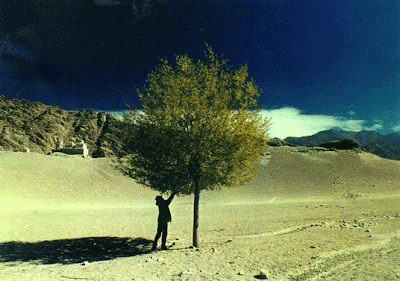
“What’s more important:
Satisfying one thousand desires or conquering just one…”
When first time I saw Pan Nalin at Rajkot, I instantly felt a spiritual vibration circling around him. I had few details on his past history of film making and personal. Having a Gujarati audience in front of him, and he being a Gujarati, shared some parts of his life with us in Gujarati language only. I was aware about his film making profile but I hadn’t watched his debut film ‘Samsara‘ which has earned 100 crores and won 30 plus awards. Hence, asking him questions about the film was meaningless during the interview that was scheduled after couple of hours. I feel that it had a meaning of me not having watched his debut directorial film before interviewing him. Of course, I had watched his second film ‘Valley of Flowers‘ but that to couple of years before and hence I didn’t remember much about it.
It was after few weeks that I could get hold of the original DVD of Samsara from Dinesh Tilva who had invited Pan Nalin to Rajkot for the launching of a book he was publisher of. Recently during a meeting at his office, I saw the DVD of Samsara and rented it instantly on friendly basis. I started watching it at 10 pm and simply went through a spiritual, deeply meaningful, spiritually sexual, humanly, romantic and an outstanding piece of combination of extremely outstanding frames.
The film is shoot in Ladakh region of India which is situated in the mountain ranges of Himalayas. The natural beauty there is so engrossing that even an upset person can easily attain peace of mind. Pan Nalin has beautifully captured every frame of valleys and mountain ranges. Every frame is a master piece. The brown and yellow resolution gives each frame a weightage of its own, let it be even for couple of seconds. A single tree situated in between the monastery and village of farmers depicts the solitude.
The story is about a young Buddhist monk named Tashi (played by Shawn Ku who is based in New York)) who has undergone a three years, three months, three days and three hours of solitary meditation in a remotely situated mountain cave. He returns from such a long solitude and starts living in the monastery. Kind of cave’s frame and of Tashi’s having long hair, long nails is absolutely outstanding and simply touches us and inspires us towards meditation. The message is simple. Everything is within. Pan Nalin frames it so beautifully that for a while it feels like existence is right here, right now.
I wouldn’t go reviewing this film in a common fashion. There are many outstanding reviews available on net if that’s what you’re looking for. Here I’m simply expressing my random views on the film and the kind of feelings it has created in me.

Upon Tashi’s return from solitude, he finds sexual awakening in him. At night he gets wet dreams. It’s indeed hard to believe that a Buddhist monk, who went over solitary meditation for years, goes through such a situation. But he too is a human, right? And so are his dreams. He hasn’t seen young woman since then, but during some religious small trip to a village, he gets aroused rather confused just by having looks at hands of a young girl, who is the daughter of their host. Pema (played by Hong Kong based actress Christy Chung), that young girl too gets some kind of attraction towards this monk. Their eyes match while Tashi leaves back for the return to monastery. Tashi beautifully expresses his feelings of attraction towards Pema without any stress of being a Buddhist monk. Upon return to monastery, Tashi finds himself circling around the million dollar question which says “What’s more important: Satisfying one thousand desires or conquering just one…” Here, the first part of question which says “Satisfying one thousand desires” talks about material world and hence Samsara where desires are unlimited where as the second part which says “or conquering just one…” talks about the path of Buddha: self-realization. Tashi choses the first and leaves the monastery at night.
Tashi knew that even Pema had feelings for her. He goes to her village; works as a farm-worker. Pema identifies him and instantly understand why he has come back! After their conversation Pema who too wanted to be with him accepts him whole heartedly. And then the two bodies meet in the lap of nature. Aah! Calling it a sexual intercourse would be simply an insulting way. It wasn’t even a simple love making but something beyond that. Rather, I would call it as being-ness! Tashi and Pema are so engrossed with each other that their every movement has a meaning which talks about the beyond-the-body relationship. The way Pan Nalin has filmed it in the jungle, having tree leaves around them is indeed fantastically done. Their kisses, hugs, sexual movements totally happen so organically that the feeling of being-the-one is felt with extreme power. Another such incidents comes at their first night, where they are shown totally nude for few seconds, making love in a Kama Sutra position where Pema is sitting on the laps of Tashi and they are again seem like eternally engrossed, becoming the one body & soul!

Sujata in Samsara
Thus starts the social life of Tashi: getting married to Pema, being a farmer, having a son, being a business oriented man when he plans to sell the grains directly to city market instead of the middle man and etc. He goes through all the social activities. Things become routine for him. He even gets physically attracted to a migrant worker Sujata (Played by Neelesha Ba Vora from Berlin). Sujata knows about it and hence one day when Pema has been out, Sujata has come to Tashi to collect her money for the work she has done. She too gets closer to him while he goes to get the money out of a jar. And then the sexuality strikes in both of them started with a kiss. Kind of position Pan Nalin framed for the short intercourse is indeed fascinating and erotic. I can’t express it in words here, you gotta watch it yourself!
Film has many most memorable frames. One of them that have touched me so deeply is the cave-houses made in the rocks. They feel like clinging there, totally out of outside world’s touch, so spiritual that it engrosses us very deeply. Once Tashi is sent to visit an old monk who lives in such a cave-house. Aah! The inner atmosphere of that cave is absolutely out of the world feeling. No extra material things. Some clothes, some pots, scriptures and that’s all.
The movie has a slow treatment which matches the spiritual message it has to give. There is no unnecessary hurry to finish up the things. Rather, you feel the flow of what’s going on. Visual treatment is fantastic. Autumn leaves, yellowish and brownish frames make the atmosphere highly spiritual.
Apart from the leading roles, rest of the casting consists of non-professional actors who are the local residents of Ladakh region. That little joker is indeed full of energy who plays the role of kid monk. Characters of Sonam, old monk, Pema’s parents have indeed done a good job.
I watched the film in original DVD and hence could watch Pan Nalin’s interview too where he talks about the film and its making. Also DVD contains making of film, soundtracks, little joker’s off-camera pranks, costume designers work etc.
Hats off to Pan Nalin for making such a wonderful film without any popular actors in it.
————–
Images courtesy: http://www.samsarathefilm.com/. copyright © Monsoon Films Pvt. Ltd. Used for information purpose only.


Previous comments:
#
Shivo- The Playful Mystic March 29, 2010 at 11:45 am
Dear Devang,
what a fantastic review you have written of the film.
However, I have just one point to add. The position you have mentioned as kamasutra position, where the female sits in the lap pf male in sexual intercourse, is called mahamudra. It is a deeply spiritual sexual pose, as when the lovers are mating, with their spine erect, energy can begin to move up, instead of moving down, as in a normal intercourse. Also, lovers can use their hands to direct the energy up the chakras. Experience of mahamudra, can help you realize the truth of osho’s discourse series “from sex to super consciousness”
Shivo- The Playful Mystic´s last blog ..Why Do We Re-incarnate? My ComLuv Profile
[Reply]
Devang Vibhakar Reply:
March 29th, 2010 at 11:33 pm
Wow! that was something new to learn. I mean, not the just name of this position but its proposed effects too. Fantastic.
Thank you Shivo.
Devang Vibhakar´s last blog ..From Samsara to Nirvana? My ComLuv Profile
[Reply]
#
Ankur Gupta March 29, 2010 at 12:29 pm
Samsara is a beautiful movie and one of those rare gems which I have seen three times…
The thousand desires dialogue also reminds you of Ghalib’s :
hazaaroN KHwahishaiN ‘eisee ke har KHwahish pe dam nikle
bohot nikle mere armaaN lekin fir bhee kam nikle
BTW even the movie Hazaron Khwaishein Aisi (2005) by Sudhir Misra is a wonderful movie.. again one of my rare movies seen twice.
Another movie showcasing Tibet – “Seven Years in Tibet”, was released in 1997, starring Brad Pitt based on an autobiographical travel book written by Austrian mountaineer and former Nazi SS Officer Heinrich Harrer (real life experiences in Tibet between 1944 and 1951). Harrer describes the contemporary Tibetan culture in detail. Harrer subsequently became a tutor and friend of the 14th Dalai Lama.
[Reply]
#
Devang Vibhakar March 29, 2010 at 10:48 pm
Hazaron Khwaishein Aisi is indeed a fantastic film. I have seen it. Between, I have added “Seven Years in Tibet” in my to-be-watched films.